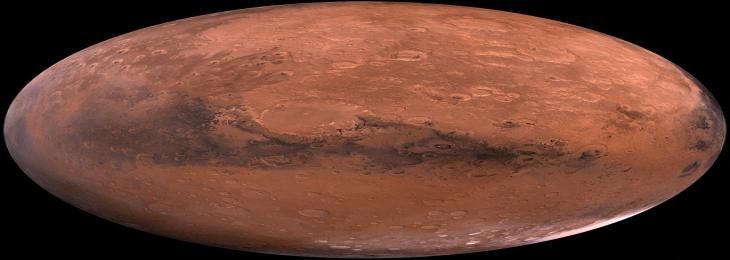
A satellite from the United Arab Emirates found that Mars' moon Deimos is made of the same stuff as the Red Planet. This suggests that they once collided in the past.
Mars' tiny moon Deimos appears to be comprised of the same materials. This contradicts theories concerning its formation. (Emirates Mars Mission photo) The UAE's Mars probe Hope returned a magnificent image of Deimos, one of Mars' two minor moons. This week, the European Geosciences Union presented March 10 flyby observations. They demonstrate that Mars and Deimos share materials. As opposed to some hypotheses, the moon formed at the same period as Mars. These observations revealed a new image of Mars and Deimos.
According to Nature.com, "Mars was in the background, and that was just mind-blowing." Most Mars probes have stuck close to the surface. Mars and Deimos are in tidal lock, thus the moon constantly faces Mars. Before Hope, Mars probes could only glimpse one side of the tiny moon.
Emirates Mars Mission (EMM) was Hope. It launched mid-2020 and reached Mars early 2021. Arab nations' first interplanetary spaceship is EMM. It examined Martian atmospheric changes. After the probe completed its original mission, the EMM team used the extra fuel to raise its orbit above Deimos. Scientists would get their first detailed view of the Martian moon's far side.
Hope snapped images of Deimos, a tiny moon 7.7 miles (12.4 kilometers) wide, approximately half the length of Manhattan, the first time it went by. These images showed the moon in ultraviolet to infrared colors. Deimos looked similar at multiple wavelengths, indicating that it is formed of Mars-like material rather than carbon-rich asteroids.
Mission leader Hessa Al Matroushi of the Mohammed Bin Rashid Space Centre in Dubai, told Nature.com continued, "If there were carbon or organics, we would see spikes in certain wavelengths." Scientists believed Deimos was a captive asteroid. Instead, it looks like an ancient Mars fragment. Earth's moon may have formed from a similar impact billions of years ago, linking our planet to its rocky red neighbor.






